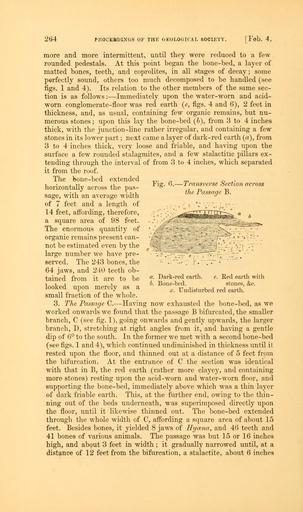MAKE A MEME
View Large Image

| View Original: | The_Quarterly_journal_of_the_Geological_Society_of_London_(12645890053).jpg (1226x2069) | |||
| Download: | Original | Medium | Small | Thumb |
| Courtesy of: | commons.wikimedia.org | More Like This | ||
| Keywords: The Quarterly journal of the Geological Society of London (12645890053).jpg 264 pitoeiiBDiXGS oe the geological society Feb 4 <br> more and more intermittent until they were reduced to a few <br> rounded pedestals At this point began the bone-bed a layer of <br> matted bones teeth and coprolites in all stages of decay ; some <br> perfectly sound others too much decomposed to be handled see <br> figs 1 and 4 Its relation to the other members of the same sec- <br> tion is as follows ” Immediately upon the water-worn and acid- <br> worn conglomerate-floor was red earth e figs 4 and 6 2 feet in <br> thickness and as usual containing few organic remains but nu- <br> merous stones; upon this lay the bone-bed 6 from 3 to 4 inches <br> thick with the junction -line rather irregular and containing a few <br> stones in its lower part ; next came a layer of dark-red earth a from <br> 3 to 4 inches thick very loose and friable and having upon the <br> surface a few rounded stalagmites and a few stalactitic pillars ex- <br> tending through the interval of from 3 to 4 inches which separated <br> it from the roof <br> The bone-bed extended _ _ m <br> horizontally across the pas- Fl ' ”Transverse Section across <br> sage with an average width the Passa 9 e B ' <br> of 7 feet and a length of <br> 14 feet affording therefore <br> a square area of 98 feet <br> The enormous quantity of <br> organic remains present can- <br> not be estimated even by the <br> large number we have pre- <br> served The 243 bones the <br> 64 jaws and 240 teeth ob- <br> tained from it are to be a - ark-red earth e Eed earth with <br> 1 j – h Bone-bed stones c <br> looked upon merely as a x Undisturbed red earth <br> small fraction of the whole <br> 3 The Passage C ” Having now exhausted the bone-bed as we <br> worked onwards we found that the passage B bifurcated the smaller <br> branch C see fig 1 going onwards and gently upwards the larger <br> branch D stretching at right angles from it and having a gentle <br> dip of 6° to the south In the former we met with a second bone-bed <br> see figs 1 and 4 which continued undiminished in thickness until it <br> rested upon the floor and thinned out at a distance of 5 feet from <br> the bifurcation At the entrance of C the section was identical <br> with that in B the red earth rather more clayey and containing <br> more stones resting upon the acid-worn and water- worn floor and <br> supporting the bone-bed immediately above which was a thin layer <br> of dark friable earth This at the further end owing to the thin- <br> ning out of the beds underneath was superimposed directly upon <br> the floor until it likewise thinned out The bone-bed extended <br> through the whole width of C affording a square area of about 15 <br> feet Besides bones it yielded 8 jaws of Hyama and 46 teeth and <br> 41 bones of various animals The passage was but 15 or 16 inches <br> high and about 3 feet in width ; it gradually narrowed until at a <br> distance of 12 feet from the bifurcation a stalactite about 6 inches 35328229 109632 51125 Page 264 Text v 19 http //www biodiversitylibrary org/page/35328229 1863 Geological Society of London NameFound Passa NameConfirmed Passa NameBankID 2996737 Biodiversity Heritage Library The Quarterly journal of the Geological Society of London v 19 1863 Geology Periodicals Smithsonian Libraries bhl page 35328229 dc identifier http //biodiversitylibrary org/page/35328229 smithsonian libraries Information field Flickr posted date ISOdate 2014-02-20 Check categories 2015 August 26 CC-BY-2 0 BioDivLibrary https //flickr com/photos/61021753 N02/12645890053 2015-08-27 11 51 09 cc-by-2 0 PD-old-70-1923 The Quarterly journal of the Geological Society of London 1863 Photos uploaded from Flickr by Fæ using a script | ||||